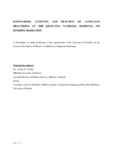| dc.contributor.author | Gecaga, W Wendy | |
| dc.date.accessioned | 2014-12-03T12:28:00Z | |
| dc.date.available | 2014-12-03T12:28:00Z | |
| dc.date.issued | 2014 | |
| dc.identifier.uri | http://hdl.handle.net/11295/76122 | |
| dc.description | Thesis Master’s in Medicine in Diagnostic Radiology | en_US |
| dc.description.abstract | The World Health Organization (WHO) Global initiative report on Radiation Safety in the
Health Care Setting of March 2010 states that low dose ionizing radiation used in diagnostic
imaging has the potential to cause detrimental health effects1.
Statement of the problem
The level of awareness of radiation risk among the clinicians in Kenya has not been documented.
Aim of the study
The aim of this study wasto evaluate and document the knowledge, attitude and practice of the
teaching hospital clinicians towards the use of ionizing radiation (IR).
Study setting
Kenyatta National Hospital
Study design
A descriptive cross-sectional study
Methodology
The study participants were a total of 170 who were distributed as follows:25 Consultants, 66
Residents, 21Medical Officers and 58 Clinical Officers. Sampling was by using simple random
method. The data was collected using well-structuredself-administeredquestionnaires and
analyzed using SPSS 17
Study duration
The study duration was 10 months from August 2013 to May 2014
Results
More consultants, residents and medical officers correctly classified the imaging modalities that
use ionizing radiation compared to the clinical officers (CO) p=< 0.004. Health workers with no
ionizing radiation (IR) training were less likely to correctly identify all the imaging modalities
that use IR compared to those with IR training (50.9% versus 27.5%; OR = 0.37, 95% CI 0.180.72).
Significantly more consultants, residents and medical officers were able to classify MRI
and US as not using IR compared to the CO p=< 0.001.When it came to identifying that an
abdominal CT has the highest radiation dose, those with formal training (69.8%) fared
significantly better than those with no formal training (37.1%) p= < 0.001.Length of professional experience, field of clinical training, and formal training in IR of the clinicians had no influence
on their knowledge of IR doses.With respect to organ sensitivity only 72 clinicians rated bone
marrow as a very sensitive organ. More clinicians rated gonads, thyroid, skin and brain as more
sensitive than bone marrow. Of the 170 health workers, 148 (87.1%) reported that IR use in
diagnostic imaging could cause harmful health effects.In their practice only 7(4.2%) considered
ionizing radiation dose an important factor when referring patients for imaging. Of the 170
clinicians,97 (57.1%) referred patients for ionizing radiation investigations where the results
would not alter the diagnosis or treatment plan. All the cadres of clinicians responded that they
rarely informed their patients on the inherent risks of IR and there was no significant difference
in their responses p= < 0.05.
Of the 170 clinicians, only 1 (0.6%) had attended a CME on IR protection.
Conclusion
The results from this study show that health workers lack the basic knowledge on ionizing
radiation doses and its harmful effects, which impacts negatively on their attitude and practice.
The implications here are serious for the patient as they are possibly being exposed to
unnecessary radiation, which could increase their risk of carcinogenesis.
Recommendations
The only way to bridge this gap is by increasing clinician awareness about ionizing radiation
through continuous medical education, development of imaging referral guidelines and
incorporating a module on medical radiation and its risks during their training pro | en_US |
| dc.language.iso | en | en_US |
| dc.subject | Ionizing radiation | en_US |
| dc.subject | Clinicians | en_US |
| dc.title | Knowledge, attitude, and practice of clinicians practising at the Kenyatta National Hospital, on ionizing radiation | en_US |
| dc.type | Other | en_US |
| dc.description.department | a
Department of Psychiatry, University of Nairobi, ; bDepartment of Mental Health, School of Medicine,
Moi University, Eldoret, Kenya | |
| dc.type.material | en_US | en_US |

